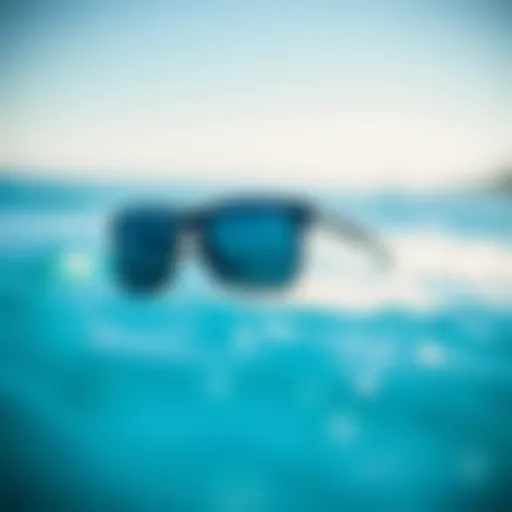Navigating the Wing Board Market: Essential Insights
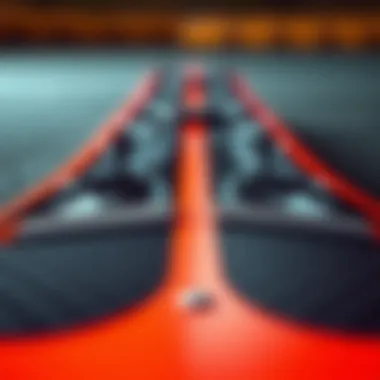
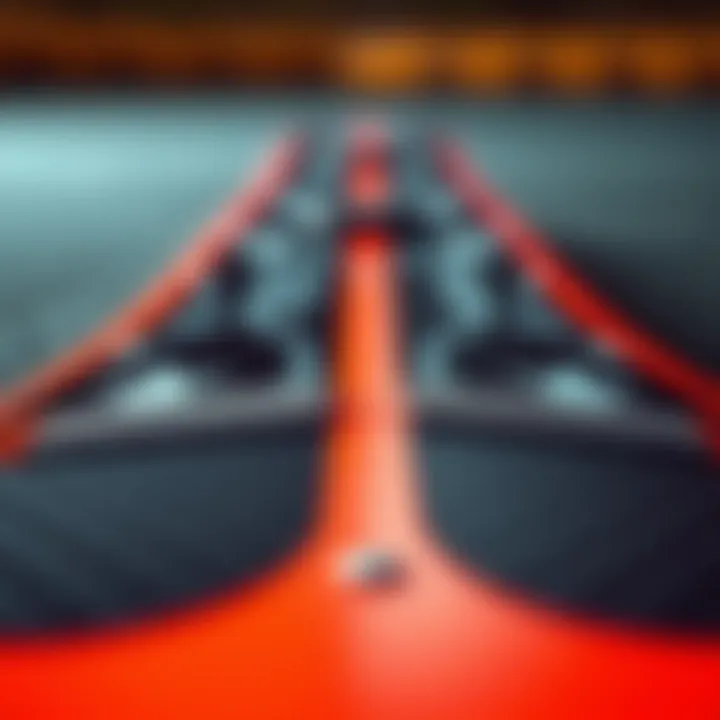
Intro
The world of wing boards has seen a surge in popularity in recent years, captivating both seasoned kiteboarders and newcomers eager to join in on the action. Understanding the market dynamics of wing boards is crucial not only for buyers but also for enthusiasts looking to enhance their performance on the water. This guide aims to encompass everything from gear selection to skill development, allowing readers to navigate their unique journeys in this niche sport.
Gear Selection
Choosing the right gear is the first step toward an enjoyable experience on the water. With various options available, selecting wing boards can be daunting for someone just starting or even for those who are well-versed in the sport. It's essential to break down the choices available to make an informed purchase.
Types of Wing Boards
The diversity in types of wing boards can be likened to sizes of shoes; what fits one person may not suit another. Common types generally include:
- Freeride Boards: Best suited for cruising and general use, these boards are versatile and great for various skill levels.
- Freestyle Boards: Designed for tricks and advanced maneuvers, these boards often feature a smaller size and are typically lighter.
- Wave Riding Boards: Tailored for turbulent and oceanic conditions, they are built to handle the ebb and flow of waves efficiently.
When selecting a board, consider your skill level and what type of riding you will be primarily focusing on.
Choosing the Right Board
Choosing the right board goes beyond just what looks appealing. Think about size, volume, and weight relative to your personal dimensions. A heavier rider may prefer a board with more volume for better buoyancy. Conversely, lighter riders often benefit from smaller boards for improved maneuverability.
Remember, the best board is one that suits your riding style, conditions, and personal comfort.
Skill Development
Once you've settled on the right gear, the next step is to develop your skills. Learning how to handle your board effectively can dramatically alter your experience on the water and boost your confidence levels immensely.
Essential Techniques
A solid foundation in the essential techniques will set the stage for each rider’s future success. Beginners should focus on:
- Balance: Finding your center of gravity is critical. Practice standing on the board while it's stationary.
- Wing Control: Understanding how to manipulate the wing is key in directing your motion.
As one gains comfort, progressing to advanced techniques like jumps or tricks becomes much more attainable.
Progression Tips
Start slow and don’t rush the learning process. Try to consistently spend time on the water, as repetition and practice help solidify skill gains. Joining local clubs or connecting with seasoned instructors can also speed up the learning curve and provide valuable insight.
In summary, whether you're wading into the market for new gear or trying to sharpen your kiteboarding skills, staying informed and deliberate is the best approach. The world of wing boards is rich and varied, and with the right knowledge, you can ensure your time on the water is nothing short of exhilarating.
Prelims to Wing Boards
The world of water sports has been transformed by the emergence of wing boards, an exciting blend of surfing, kitesurfing, and windsurfing. This section aims to unpack the realm of wing boards, illuminating their significance in today's sporting landscape. Understanding wing boards not only enhances the riding experience but also opens up new avenues for enjoyment and skill development in those passionate about water activities.
What are Wing Boards?
Wing boards are innovative watercraft designed for powered rides, utilizing a handheld wing to harness wind energy. These boards enable riders to glide smoothly over water, offering an exhilarating experience both for beginners and seasoned pros. Unlike traditional kiteboards or sailboards, wing boards allow greater maneuverability, making it easier to learn and master various techniques.
Typically, a wing board consists of a board, a detachable wing, and sometimes a foil, depending on the rider’s preference. Riders can go upwind and downwind with ease, making them a popular choice for those who enjoy thrills without the complexity of kite setups. The compact design ensures they can be transported easily, allowing enthusiasts to hit the waves wherever they go.
History and Evolution of Wing Boards
The evolution of wing boards traces back to kitesurfing's gradual diversification. Early prototypes began appearing in the 2000s as inventors sought more adaptable water sports equipment. These fledgling designs laid the groundwork for the modern wing board, which started gaining traction in the early 2010s.
As enthusiasts experimented with various designs, a community formed around sharing insights and ideas. Feedback on wing shapes, sizes, and materials fostered continuous innovation. Fast forward to today, and manufacturers such as Starboard, Duotone, and Naish have fine-tuned wing board technology, with advanced construction materials that make these boards lighter, stronger, and better at catching wind.
The growth of wing boarding wasn't simply in the gear—events and competitions began popping up worldwide. Wing foil racing, for example, showcased the increasing popularity and competitive spirit within the sport. Through each advancement, enthusiasts celebrated a newfound freedom on the water that combined elements from multiple water sports, resulting in a vibrant subculture that invites both athletes and spectators to enjoy the thrill of riding atop the waves.
"Wing boards exemplify the convergence of innovation and play. They’re not just a product— they represent a lifestyle that resonates with adventure seekers and water enthusiasts across the globe."
Rentals and instructional classes have become more prevalent in beach towns, helping novices take their first strides into this exciting sport. Weekly meetups, forums on sites like Reddit, and vibrant social media groups foster a sense of community where tips, experiences, and excitement is shared.
In summary, the history and evolution of wing boards reflect an adaptive trend within water sports, embracing change and innovation, and appealing to a broad demographic—from weekend surfers to competitive racers. As this sport continues to grow, the understanding of wing boards becomes key for anyone wishing to immerse themselves fully into this exhilarating watery adventure.
Learnings from the past and present lay the groundwork for the future of wing boards, making it vital for enthusiasts and industry players alike to stay informed.
Understanding the Wing Board Market
The market for wing boards has evolved significantly over the years, transforming from a niche area within water recreation to a booming segment in the outdoor sports industry. Understanding this market is essential, as it provides insights into current trends, consumer preferences, and the overall trajectory of wing boards as they relate to the kiteboarding community. For enthusiasts—from experienced riders to budding novices—this knowledge is crucial for making informed decisions about purchases and staying relevant in the sport.
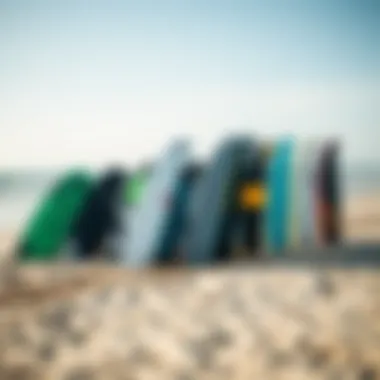
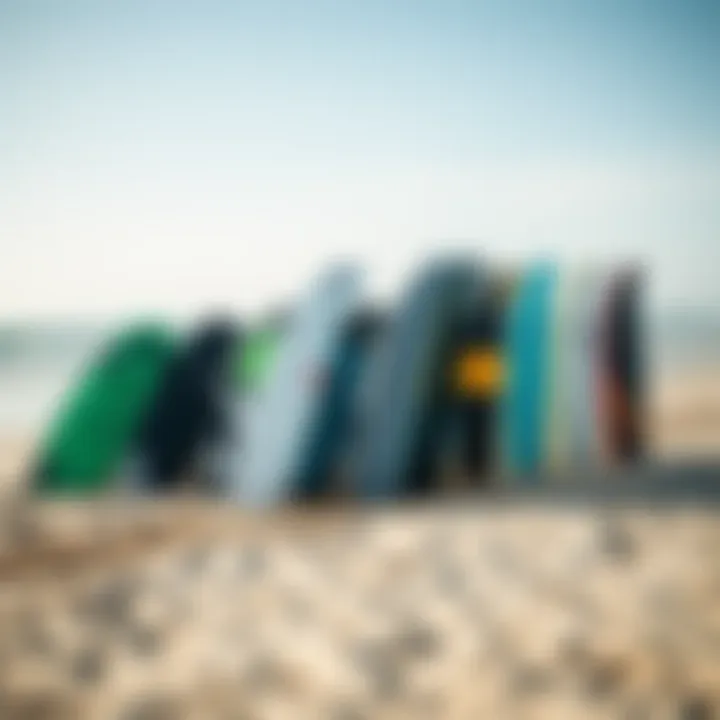
Current Trends in Wing Board Sales
In recent years, wing board sales have seen a notable uptick. Factors like the increase in outdoor activities during the pandemic played a large role in this surge. Many consumers have turned towards wind sports as a way to enjoy the great outdoors while maintaining social distance. Reports indicate that sales of wing boards have risen by approximately 50% in the last two years.
In addition, manufacturers have begun releasing a wider variety of products catering to different skill levels and preferences. From sleek designs to boards suited for wave riding, the current market has something for everyone.
"Innovation in wing board technology has shifted the paradigm in kiteboarding, driving consumer interest and sales."
Key Players in the Wing Board Industry
There are several dominant brands shaping the wing board industry today. Companies like Duotone, F-One, and Slingshot have carved out substantial market shares by consistently innovating and improving their product lines. These brands are recognized for their commitment to quality and their ability to incorporate consumer feedback into their designs.
- Duotone is praised for its lightweight materials and cutting-edge design, appealing to both professionals and enthusiasts alike.
- F-One stands out for its eco-friendly approach, ensuring that performance does not come at the expense of the environment.
- Slingshot is known for its versatility, offering boards that cater to both beginners and seasoned pros.
The competition keeps these brands on their toes, encouraging continuous improvement in performance metrics and design elements.
Market Demand and Consumer Behavior
When it comes to market demand, the psychology of the consumer plays a significant role. Factors influencing consumer behavior include price sensitivity, brand loyalty, and the desire for high-performance equipment. Many riders are willing to invest in premium products if they believe the value justifies the cost.
Moreover, social media has become a significant driving force in how consumers perceive wing boards. An increasing number of influencers and online communities share their experiences on platforms like Reddit and Facebook, which helps new buyers make decisions about which products are worth considering.
In summary, understanding the wing board market is not just about knowing the products available. It encompasses recognizing trends, key industry players, and consumer behavior that shapes buying experiences. By staying informed and engaged, kiteboarding enthusiasts can find equipment that best suits their style and needs.
Types of Wing Boards Available
The growing popularity of wing boarding, a thrilling fusion of wind and water sports, necessitates understanding the diverse types available on the market. Each type of wing board is designed to cater to different skill levels, riding styles, and conditions. By comprehending these differences, potential buyers can make an informed decision that aligns with their preferences and capabilities.
Foil Wing Boards
Foil wing boards have gained a strong following due to their ability to glide smoothly over the water's surface, a feature that creates an almost surreal sensation of flying. These boards are equipped with a hydrofoil—essentially a wing submerged beneath the waterline—which lifts the board above the surface.
Key benefits of foil wing boards include:
- Reduced Drag: The design minimizes drag, allowing riders to harness the wind's power efficiently.
- Increased Speed: Riders can reach higher speeds compared to traditional boards.
- Stability: The foils offer a more stable ride once airborne, generating a smoother overall experience.
However, it's crucial to consider a few factors. For instance, these boards can be challenging for beginners due to the learning curve associated with balancing on a hydrofoil. Thus, investing in a foil wing board may be wise for those already well-versed in water sports.
Solid Wing Boards
Solid wing boards are more traditional and simpler in construction. They are typically made from durable materials designed to withstand the rigors of frequent use. These boards are heavier than their foil counterparts but provide a stable platform for a variety of riding styles, especially for those just starting out.
Benefits of solid wing boards include:
- Easier for Beginners: They provide better stability when learning, allowing new riders to understand the basic mechanics of wing boarding without the complexities of foiling.
- Versatile Usage: Riders can use them for various water sports, including kiteboarding and windsurfing, making them a good fit for multi-sport enthusiasts.
- Durability: Built to withstand rough conditions, solid boards tend to last longer in demanding environments.
Despite these advantages, solid boards may limit speed and agility compared to foil designs. Hence, they could be a suitable choice for amateurs who later wish to transition into more advanced styles.
Hybrid Boards
Hybrid boards represent a middle ground in the wing board world, combining features of both foil and solid boards. Their design often includes removable foils, which allow riders to switch between a conventional ride and a foiling experience, providing a versatile option for various conditions.
The upsides of hybrid boards include:
- Flexibility: Riders can adjust their experiences based on their comfort level and environmental conditions, whether they prefer the grounded feel of a solid board or the exhilarating lift of a foil.
- Cost-Effective: Purchasing a hybrid board may serve as a two-in-one investment, allowing progression without needing multiple boards.
- Adaptable Features: They often offer different board sizes and shapes to cater to a wide range of skill levels.
However, some riders may find them less specialized, as hybrids often do not outperform dedicated solid or foil boards in either category. Thus, a hybrid can work well for those dipping their toes into the sport, but advanced riders may want to choose one type based on their skills and personal preferences.
In summary, understanding the types of wing boards available can help guide purchasing decisions that enhance the riding experience. From foil boards offering speed and agility to solid boards providing stability for beginners and hybrids offering versatility, each type serves a unique purpose within the dynamic world of wing boarding.
Technical Specifications of Wing Boards
When it comes to wing boards, technical specifications play a pivotal role in recognizing their performance and suitability for various riders. For anyone looking to dive into the wing boarding experience, understanding these specs can mean the difference between carving waves like a pro or splashing down during an attempted take-off. Not only do these details shape the performance of the board, but they also influence durability and handling characteristics. Choosing a wing board with the right specifications can significantly lead to enhanced experiences on the water, particularly for both novice and seasoned kiteboarders alike.
Material Composition
The material composition of wing boards significantly influences their weight, durability, and ride characteristics. Most boards are crafted using a mix of materials, including fiberglass, carbon fiber, and EPS foam. Fiberglass is popular for its balance of strength and flexibility, making it ideal for general use. Conversely, lightweight carbon fiber is often used in high-performance boards, offering extreme stiffness and responsiveness, although at a higher price point.
Common materials used include:
- Fiberglass: Durable and affordable, suitable for beginner boards.
- Carbon Fiber: Lightweight and stiff, providing better performance but at a steeper cost.
- EPS Foam: Used for buoyancy, often layered with other materials for strength and durability.
When exploring wing boards, consider how these materials suit your style. For instance, if you're an adrenaline-seeker who loves speed, a carbon-fiber board can provide the nimbleness needed for high-octane maneuvers.
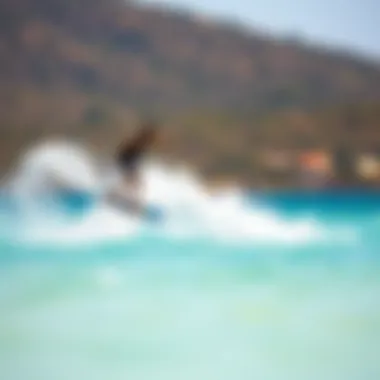
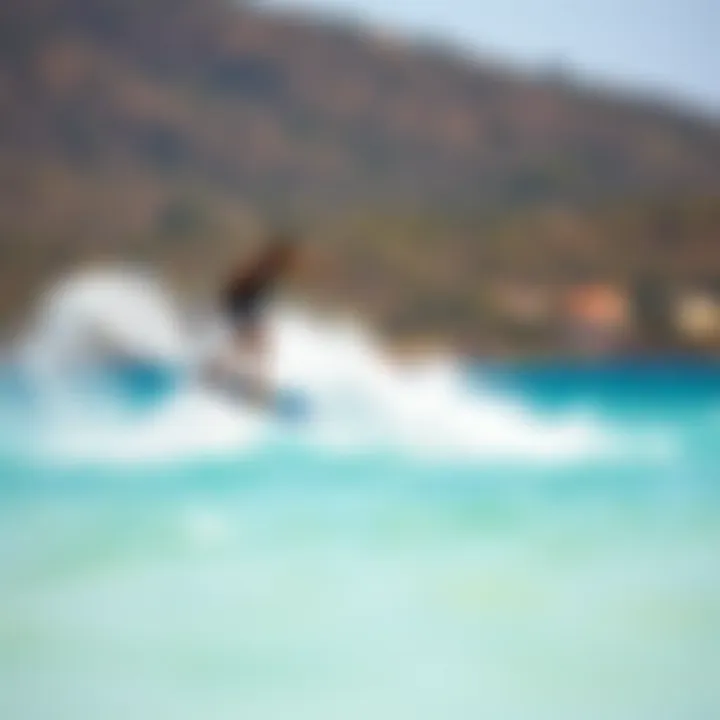
Performance Metrics
Performance metrics are crucial as they define how well a wing board handles under variable conditions. Factors such as volume, weight, and rocker line shape can drastically affect performance.
- Volume: Determines buoyancy and stability. Higher volume boards are ideal for lighter riders or in low-wind conditions.
- Weight: Lighter boards provide improved handling and ease of transportation, useful for those who need to carry gear to remote spots.
- Rocker Line: The curvature of the board that affects speed and maneuverability. More rocker means easier turns but can reduce speed, while flatter boards can glide faster but may be less agile.
A proper understanding of these metrics allows enthusiasts to select boards tailored to their specific riding goals. For example, if you're just starting, opting for a board with moderate volume and a balanced rocker can aid in stability while you learn.
Design Considerations
The design of a wing board encompasses not only aesthetics but also functional elements that affect performance. These factors include tail and nose shape, fins configuration, and overall dimensions.
- Tail and Nose Shape: These influence water release and how the board rides through choppy conditions. Wider tails improve lift, while pointed noses cut through water better.
- Fins Configuration: More fins can provide extra control, but they also add drag. A single fin setup may allow for a more fluid ride, better suited for freestyle tricks.
- Board Length and Width: Longer boards tend to provide more stability for beginners, while shorter boards offer greater maneuverability but require more skill.
Ultimately, the design of a board should align with your riding style—whether cruising, jumping, or executing tricks. The right design elements can make your rides more enjoyable and successfu.
"Exploring the technical specifications before making a wing board purchase is like having a map in an uncharted territory—without it, you may stray off course."
Understanding the importance of material composition, performance metrics, and design considerations will empower potential buyers in the wing board market to select options that align with their skills and ambitions.
Factors Influencing Wing Board Prices
When venturing into the realm of wing boards, one pivotal aspect that consumers must consider is the pricing. Understanding what drives these prices can equip buyers with the ability to make wiser choices. Here, we dive deep into the nuances that shape the cost of wing boards, exploring elements such as brand reputation, innovation, and market competition.
Brand Reputation
Brand reputation plays a significant role in the wing board market. Established brands such as Slingshot and Duotone often command higher prices due to their long-standing history of quality and reliability. A brand with a solid reputation isn't just about flashy marketing; it's about trust built through years of durable products and customer satisfaction.
- Quality Assurance: A reputable brand tends to undergo stringent quality control, ensuring that every product that leaves the production line meets high standards. This typically results in a better user experience, which justifies the price tag.
- Customer Support: Big names often provide robust customer service, including warranty and repair options. This added value can make a higher initial investment worthwhile in the long run.
- Resale Value: Well-known brands often retain their value better than lesser-known ones, offering better prospects if you decide to sell your gear later.
In a crowded marketplace, it’s essential to weigh the benefits of investing in a trusted name against potentially cheaper alternatives.
Innovation and Technology
The technological advancements within the wing board sector cannot be overlooked when evaluating prices. Many high-end boards incorporate cutting-edge materials and innovative designs aimed at enhancing performance and rider experience.
- Material Quality: Boards made from carbon fiber or advanced composite materials often come with a higher price range. These materials not only reduce weight but also improve durability and responsiveness.
- Performance Features: Features like adjustable straps, lighter designs, and enhanced aerodynamics contribute to improved performance on the water. Cutting-edge tech can enhance speed and maneuverability and consequently raise the price of the board.
- R&D Investment: Companies that prioritize research and development tend to integrate the latest innovations into their products. This involvement involves significant expenditure, which is usually reflected in the retail price.
Investing in a technologically superior board often pays off in terms of performance and longevity, making it a worthy consideration for serious enthusiasts.
Market Competition
The level of competition within the wing board market can also sway prices. When several brands compete for consumer attention, it often leads to more competitive pricing strategies. However, this isn’t always straightforward.
- Price Wars: In highly competitive segments, brands may drop their prices to entice buyers, leading to lower costs for consumers. This can work to the advantage of price-sensitive buyers.
- Niche Products: If a particular brand specializes in unique or niche designs, it may set a premium price as it can create a limited consumer base willing to pay for specialized products.
- Consumer Trends: As trends evolve, manufacturers may adjust their prices based on consumer demand. For instance, if a new wing board design gains traction, expect prices to reflect that interest.
Ultimately, examining market dynamics can help buyers identify opportunities to snag quality boards at competitive prices.
"Emphasizing quality over cost can yield a more rewarding adventure on the water. Remember, a good wing board isn’t just a purchase; it’s an investment in your pursuit of adventure."
In summation, pricing in the wing board market is influenced by a medley of factors including brand reputation, technological innovation, and competitive dynamics. Buyers ought to consider these aspects carefully, ensuring that they align their expectations with what is offered, leading to a more satisfying purchase decision.
Buying Considerations for Wing Boards
When it comes to purchasing a wing board, potential buyers need to meticulously weigh several factors before making that leap. Understanding these considerations not only enhances the buying experience but also ensures that enthusiasts end up with a board that aligns perfectly with their skills and ambitions. Wing boards come in many shapes and designs, catering to a range of abilities, so taking the time to evaluate personal needs can make a significant difference. Here’s an in-depth look into what to keep in mind when making this choice.
Evaluating Skill Level and Needs
Assessing your own skill level is a crucial first step in the wing board buying process. It’s not just about how many times you’ve hit the water; understanding your riding style and preferences plays a pivotal role. Novices might focus on boards that offer stability and ease of control, whereas seasoned riders might prioritize performance and speed.
- Beginner Riders: Look for wider boards with more volume that provide enhanced stability in choppy waters. A board like the North Reach is a solid choice, as it allows beginners to gain confidence and develop their technique without feeling overwhelmed.
- Intermediate Riders: You might start exploring more versatile shapes that balance performance and maneuverability. For example, a model like the Fanatic Sky might provide the right mix, allowing for progression while still being forgiving.
- Advanced Riders: If you’re a more experienced rider, you might have specific demands such as responsiveness and high-speed capabilities. Boards like the Duotone Board are engineered for experts looking to push their limits.
Tailoring your selection based on your skill level can improve your experience drastically.
Trial and Testing
Nothing beats the ability to physically test a wing board before making a commitment. Many shops and sporting goods stores offer demo days or rental options that allow potential buyers to experience a board firsthand. This practical approach can save you from the buyer's remorse that sometimes accompanies online purchases.
- Test Ride: If you find a local event or a kiteboarding school, take advantage of the opportunity to try different boards. Handling various styles might reveal preferences you did not know you had.
- Feedback: Don’t hesitate to ask instructors or other riders about their experiences with different boards. They may provide insights that can guide you toward making an informed decision.


The feel of a board on the water can make all the difference. Testing can reveal things about performance that specs may not capture.
Purchasing Options: Online vs. Retail
Deciding between shopping online and visiting a physical store can influence not only your selection but also your buying experience. Each option has its own pros and cons.
Online Shopping:
- Typically offers a larger selection of boards, often at lower prices. Websites like evo.com and boardcave.com have extensive listings.
- You can read reviews and comparisons more easily, putting the collective experience of the community at your fingertips. However, unless you’re experienced, it can often be challenging to ensure the board suits your needs without trying before buying.
Retail Stores:
- Immediate access to professional knowledge with staff to help guide your choices. Getting hands-on with a board can create a connection that purchasing online simply cannot replicate.
- You’ll also have the opportunity to inspect the board for quality and build, which can be difficult to assess through a screen.
Each choice has its place, and carefully deliberating which method aligns best with your buying objectives is key. Respective benefits ensure you’re not leaving any stone unturned.
Care and Maintenance of Wing Boards
Taking proper care of your wing board is crucial to ensure its longevity and performance. Just like any piece of sporting equipment, regular maintenance not only helps in preserving its structural integrity but also enhances your riding experience. Damage from neglect can be severe; little things, such as sand and saltwater, can make the best wing board look like an old shoe if not tended to with care. Maintaining your wing board encompasses cleaning, safe storage, and knowing when and how to conduct repairs or upgrades.
Cleaning and Storage
Cleaning your board after each session is not just a suggestion; it's a necessity. Once you return from the water, it’s best to rinse your wing board with fresh water. This simple act can wash away the sand, salt, and debris that can otherwise accumulate and cause wear over time.
- Steps for Cleaning:
- Use a gentle sponge to scrub any residual dirt or sand.
- Avoid harsh chemicals; they can damage the board’s surface.
- Dry it off with a soft towel to prevent any water spots or mineral buildup.
When it comes to storage, be sure to keep your board in a cool, dry area. Prolonged exposure to direct sunlight can fade and weaken the materials. It’s wise to invest in a board bag; this not only provides protection against UV rays but also against accidental bumps and scrapes. Storing it vertically or flat helps maintain its shape and prevents warping.
Repairs and Upgrades
No matter how careful you are, accidents happen. Knowing the basics of repairs can save you both time and money. Minor dings or scratches can usually be self-repaired with a simple epoxy resin kit, which can be found at many sporting goods stores or online.
- Common Repairs:
- Use sandpaper to smooth the surface around a ding.
- Apply the epoxy resin as directed and let it cure fully.
- For serious damage, consider reaching out to a professional repair shop.
Upgrading components, like the fins or straps, can improve your riding experience. Brands often release updated models with enhancements in materials or designs, which can translate into better performance on the water. Whenever you're considering an upgrade, read reviews and do a bit of research—sometimes a small change can lead to significant improvement in performance.
"Proper care not only extends the life of your wing board, but also ensures that you continue to enjoy every single session on the water."
Keeping these care tips in mind will help you enjoy a seamless experience while riding. If you can treat your wing board well, it will treat you better, ensuring that each wave is ridden with trust in your equipment.
Wing Boards and Kiteboarding Culture
Impact on the Kiteboarding Community
Wing boards have made a significant mark in the kiteboarding community, emerging as a revolutionary tool for both seasoned riders and newcomers. The allure of these boards lies not just in their performance, but also in how they embody the spirit of innovation that characterizes the sport. Unlike traditional kiteboards, wing boards offer greater maneuverability and the freedom to ride in different wind conditions. This has fostered a culture that embraces experimentation and exploration on the water.
The introduction of wing boards has consequently created a ripple effect in the kiteboarding community. Riders have been quick to adopt and share their experiences through social media platforms, creating an engaging dialogue around new techniques and tricks. Enthusiasts, instructors, and event organizers have also emphasized the importance of community events focused on wing boarding. These gatherings allow participants to showcase their skills, share insights, and motivate one another within an increasingly competitive landscape.
Beyond individual experiences, the wing board culture emphasizes sustainability and inclusivity. Riders often engage in beach clean-ups or environmentally focused gatherings that educate the community on the importance of protecting the oceans. As more people take to the waters with wing boards, the community's collective voices become stronger in promoting responsible practices in the sport.
Environmental Considerations
As the popularity of wing boards continues to soar, an undeniable responsibility arises within the kiteboarding community regarding environmental considerations. The sport's growth must align with sustainable practices to protect the natural wonders that make kiteboarding possible.
Wing boards are often made from materials that can vary in their environmental impact. For instance, many brands are now investing in eco-friendly materials and manufacturing processes. This shift not only minimizes the carbon footprint but also sets a precedent for future production practices within the industry.
Moreover, wing boarders frequently harness the wind to glide across the water, emphasizing a clean energy source in their performance. This reflects a growing consciousness among riders about the need for sustainable recreation. Riders are increasingly aware of their surroundings, which has led to a community-led shift towards cleaner beaches and oceans, evidenced by organized environmental events and outreach programs.
In summary, the intertwining of wing boards and kiteboarding culture is marked by innovation, community spirit, and a commitment to environmental stewardship. As riders embrace these boards, they also embrace their role as stewards of the sport and the ocean. This creates a harmonious blend where fun and responsibility can coexist, paving the way for a sustainable future.
The growth of wing boards brings both excitement and responsibility to the kiteboarding community, emphasizing the importance of sustainable practices in ensuring the future of the sport.
The End
As we navigate through the ever-evolving realm of wing boards, it becomes clear just how vital a thorough understanding of this market is for enthusiasts and newcomers alike. The significance of grasping the key aspects of wing boards, from types to maintenance, cannot be overstated. This guide has hopefully provided practical insights meant to empower consumers, ensuring they make well-informed decisions.
Future Prospects for Wing Boards
The horizon looks promising for the wing board industry. Innovations continue to shape the future, with companies focusing on lightweight materials and advanced designs that enhance performance. The push for sustainability is also transforming the market, as more brands commit to using eco-friendly materials. As people seek new ways to connect with water sports, wing boards are likely to gain more traction, not just in fresh water locations but also in coastal areas. Overall, the future of wing boards appears bright, suggesting that this sport may not just be a fleeting trend but a long-term segment in the world of water sports.
Final Thoughts
In wrapping up, it’s essential to reflect on the journey of wing boards and their impact on both individual experiences and the larger kiteboarding community. This guide has aimed to offer clarity amidst the chaos of choices in the market. Whether one is eyeing their first purchase or looking to upgrade, the right information is key. The passion for kiteboarding and wing boarding will only grow, pairing nicely with advancements in technology and design. With the right insight, you can fully enjoy the exhilarating ride that comes with wing boarding.







